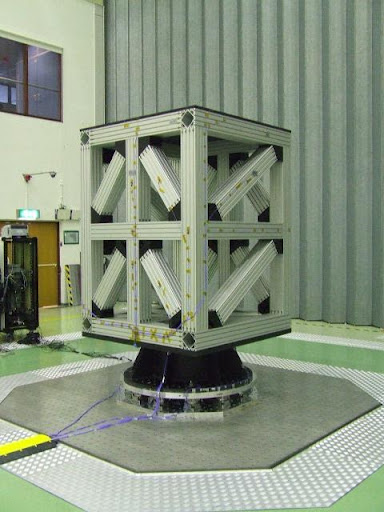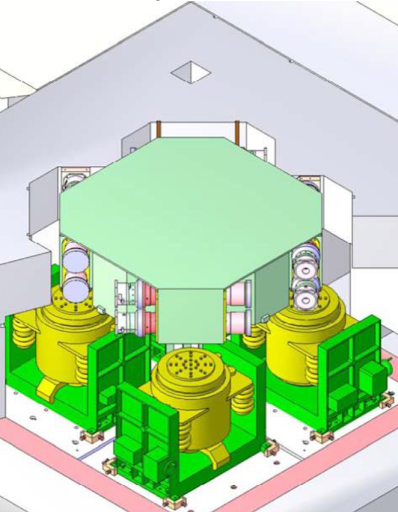640kN QUAD shaker
General Description
The 640kN QUAD shaker is a sophisticated vertical electro-dynamic vibration test facility for large spacecraft payloads with a mass of up to 10 tons. The four identical shakers are water-cooled electro-dynamic shakers based on a long-stroke vibrator V984 with a nominal thrust of 160kN each. The outstanding thrust vector of the facility is paramount for high-g out-of-plane tests on large satellite dishes or solar panels. Same as the DUAL shaker facility, the QUAD operates in a frequency regime of 3Hz - 2000Hz. Another special feature of the QUAD shaker facility is the dedicated peripheral guiding system consisting of 16 large hydrostatic bearings that keep the octagon shaped head expander strictly moving in vertical excitation direction, thereby minimising cross-talk and facilitating high overturning moments. A full-blown structural analytical model of the facility is available for coupling with the specimen model to predict test item behaviour.
640kN QUAD shaker
Test modes
The vibration input is generated by a state-of-the-art vibration controller with up to 48 control and measurement channels, all usable for test article response limiting.
A variety of types of excitation is available:
- Sine testing, e.g. sine sweep, tracked sine dwell
- Random testing
- Transient testing, e.g. classic half sine shock, saw-tooth, transient waveform replication/SRS
Test article responses are measured by a dedicated mechanical data handling system, offering up to 800 channels.


Mechanical Interface
The magnesium alloy head expander connected to the four shakers creates a 3.3x3.3m interface for payload installation. The design of the head expander is optimised for maximum out-of-plane interface stiffness and low own weight. A set of pressurised air bellows compensates for the static load of the expander-payload assembly during vibration tests. The expander interface plate is equipped with 1537 M10 inserts on a 80x80 mm grid pattern and has a flatness of less than 0.1mm/m to facilitate proper load transfer to the payload.

